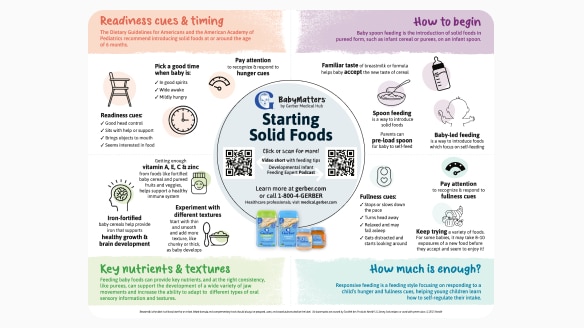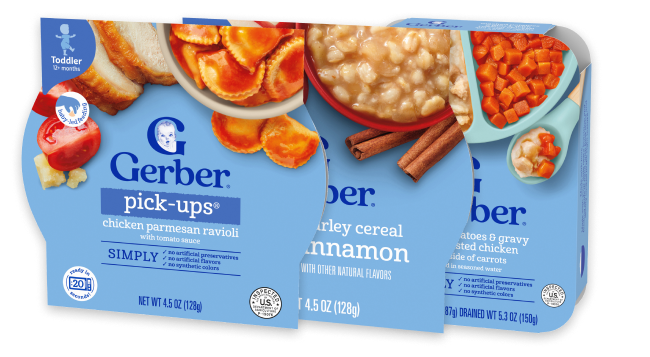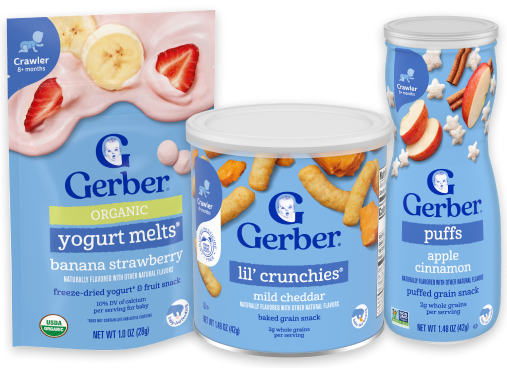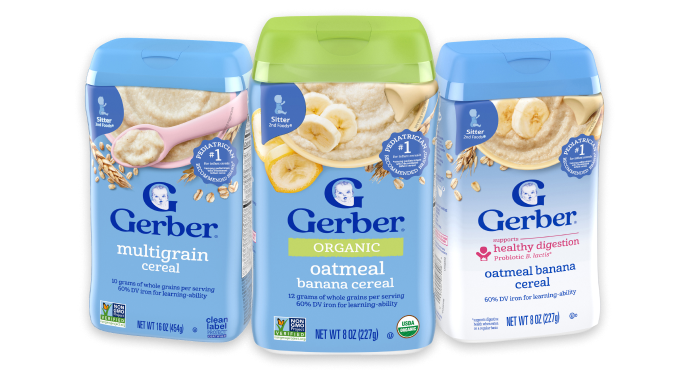Gerber Baby Foods
Gerber baby foods provide diet diversity and nutrition. Our foods are made from wholesome and nutritious fruits, vegetables, grains and meats. Geber purees are specifically designed to help babies experience new tastes and textures while providing essential nutrients from nutrient dense foods.
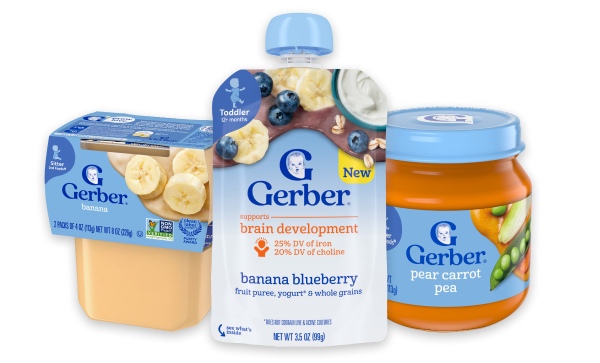
Role of Gerber Baby Foods in the Diet
Aligns with DGA recommendations
Gerber baby foods in tubs, jars and pouches are made from nutrient dense foods representing all the food groups as recommended by the Dietary Guidelines for Americans.
Helps oral development & learning to eat
Feeding purees supports the development of a wide variety of jaw movements and synchronizes the sucking-chewing-swallowing experience.
Our highest quality ingredients
Gerber purees are made from fruits and vegetables that follow our Clean Field Farming Practices that guide the way we thoughtfully select our seeds and land, sustainably care for the soil, and trace our harvested crops not only to the farms, but to the very fields where they were grown.
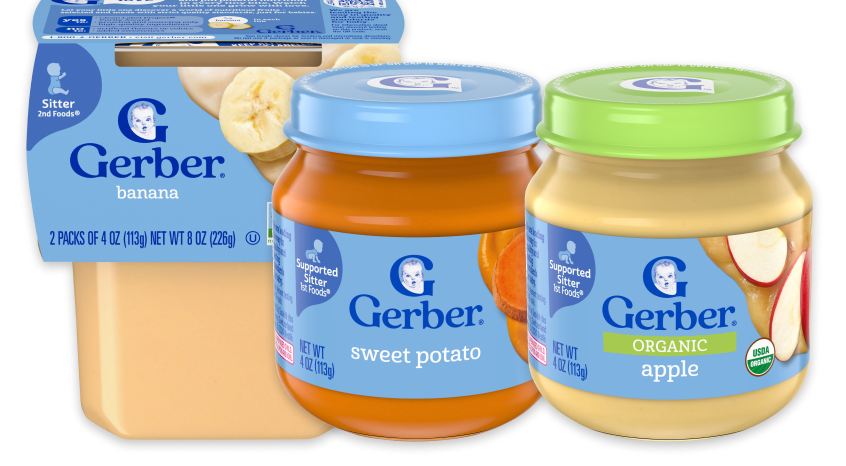
Single Ingredient Foods
Supported Sitter: From starting solids & up
Babies can start a lifelong love of fruits and veggies with these single fruit and vegetable baby foods.
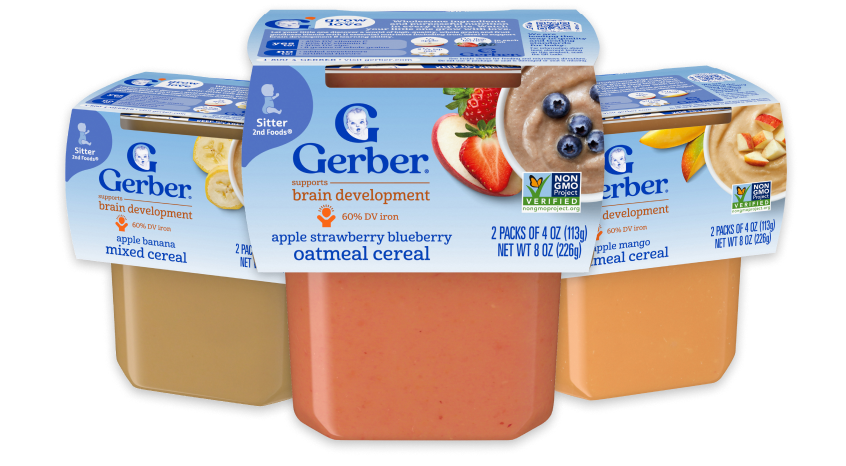
Ready-to-Eat Cereal Purees
Sitter: From around 6+ months & up
Gerber Grain & Grow ready-to-eat cereal purees provide the nutrition of infant cereal, including iron and zinc, in a ready-to-eat puree.

Puree Blends
Sitter & Crawler: From around 6+ months & up
Our recipes offer babies a variety of tastes and textures to support diet diversity along with important nutrients such as vitamin C, vitamin A and potassium.

Dinners & Meats
Sitter & Crawler: From around 6+ months & up
Gerber dinner recipes, meats and meat sticks varieties are an easy way to offer foods from the meat food group. Meats are important in the diet for protein, iron, zinc and vitamin B12.
Patient Resources and Practice Tools
Nutrition Assistance Programs

WIC
We are proud to be one of the largest infant food providers to the Supplemental Nutrition Program for Women, Infants, and Children (WIC). Gerber is the only baby food brand approved across all 50 states with options for each category of the WIC Infant Food Package.
View WIC authorized products
CACFP
We’re committed to being your partner in childcare by providing high quality, nutritious foods that meet the Child and Adult Care Food Program (CACFP) Meal Patterns
View CACFP eligible productsCACFP creditable infant products PDF
Related Research and References

Baby food vegetables provided by the Women Infants and Children program (WIC) has helped increase vegetable consumption.

Dietary Guidelines for Americans highlight priority nutrients to be provided with foods in the diets of infants and toddlers.
Various Gerber baby foods help provide essential nutrients such as calcium, iron, zinc, vitamin D, fiber, potassium, protein, omega-3 and fatty acids, vitamin A and vitamin C.

Prepared baby foods are nutritious
Fruits and vegetables prepared in different ways allows for intake of different nutrient profiles from fresh and cooked fruits and vegetables. Nutrients vary widely by kinds of fruit and vegetable, more so than how it is prepared, so expert advice for getting nutrients from fruits and vegetables is to have a wide variety in the diet and baby food varieties are nutritious choices that make it easy to get variety into the diet.

Most baby foods do not contain added sugar regardless of packaging
A study on baby foods found that more than 90% of pouches, jars, and tubs for infants and toddlers are free from added sugar, except for yogurt-based products. Packaging type doesn't affect sugar content, but yogurt presence predicts added sugar. Pureed foods without yogurt rarely contain added sugar. Similar fruit and vegetable consumption was observed in pouch users and non-users.

Pouch use among infants does not impact exposure to other forms of fruits and vegetables: data from the Feeding Infants and Toddlers Study (FITS) 2016
This study examined baby food pouch usage and its influence on fruit and vegetable consumption among infants (6-11.9 months). About 32% of infants used pouches, but daily usage was infrequent. Pouch users consumed fruits and vegetables as often as non-users, indicating that pouches don't limit exposure to other produce forms. The study suggests that the impact of baby food pouches on infants' oral motor development is likely minimal.
Answers to Top Parent Questions
What's the difference between GERBER® 1ST FOODS®, GERBER® 2ND FOODS®, and GERBER® 3RD FOODS®?
GERBER® 1ST FOODS® products are designed for babies starting solids in the supported sitter milestone and include Supported Sitter purees, such as Gerber® 1st foods® fruits and veggies. These single ingredient purees support easy swallowing.
GERBER® 2ND FOODS® products include many fruits and vegetables your baby enjoyed in the GERBER® 1ST FOODS® line, but there are many new varieties and combinations of ingredients. These foods are typically introduced in the Sitter stage.
GERBER® 3RD FOODS® have advanced textures for Crawler babies learning to chew. The puree is thick, with pieces of food that are just the right size to help baby start to manage multiple textures and transition to toddler food.
Do Gerber baby food purees contain common food allergens?
Gerber® food label ingredient statements are the most accurate source of food allergen information. Recipes may change so it's important to read the label each and every time you purchase a product for a child with a food allergy. When present in our foods, the Top 9 FDA recognized food allergens are listed in the ingredient statement in consumer friendly terms as well as immediately after the ingredient list in a "contains" statement. What are the top 9 you ask? Milk, egg, wheat, soy, peanut, tree nuts, fish, shellfish and sesame.
Find out more about common food allergens in in products from our Allergen Finder or Contact us
Do Gerber baby foods need to be heated?
No. All baby foods can be served cold, warm, or at room temperature. Your baby may not have a preference for warmed foods, so it's not necessary. But you may want to warm refrigerated food to room temperature.
Getting more questions about product preparation – Contact us

